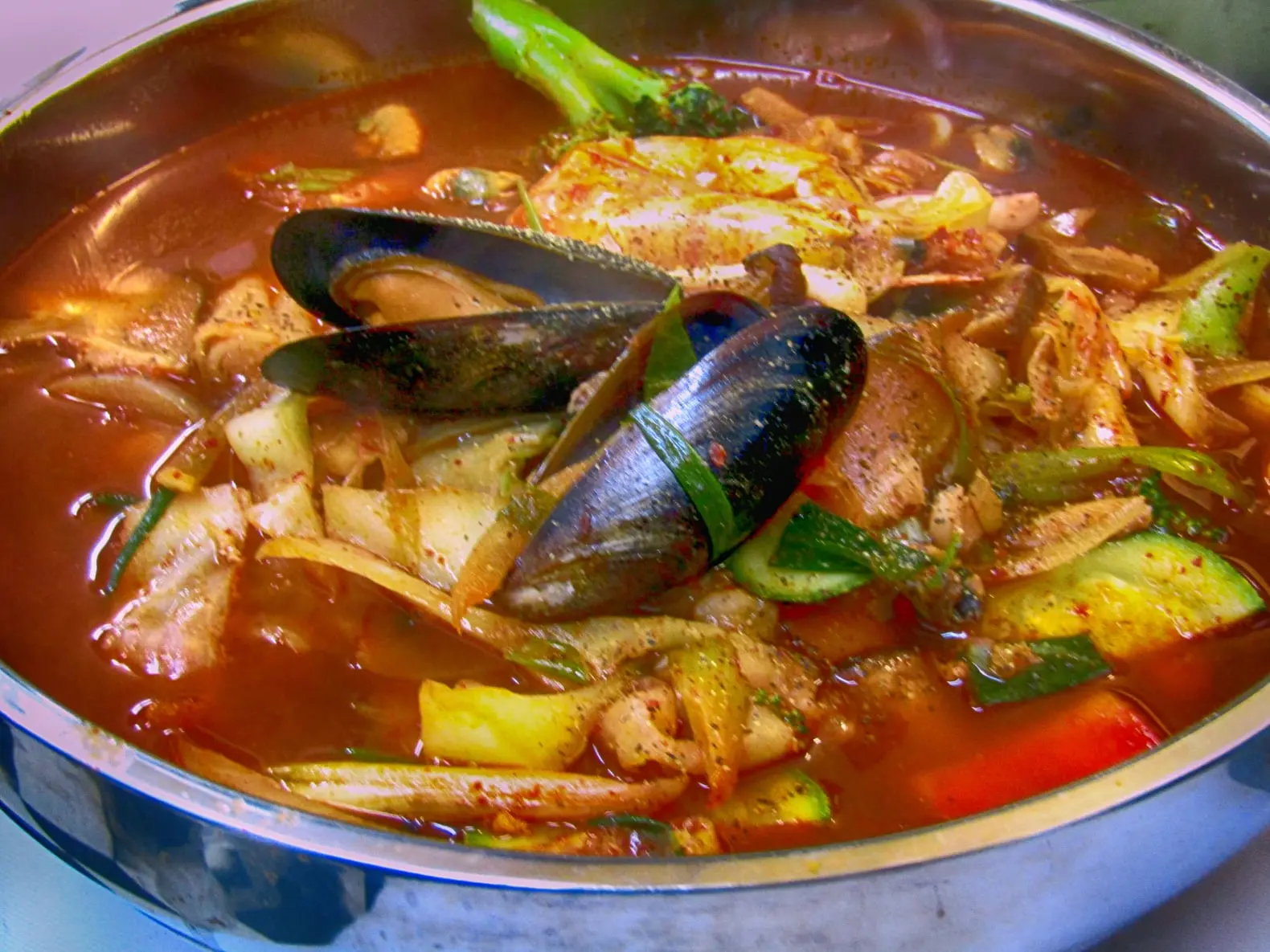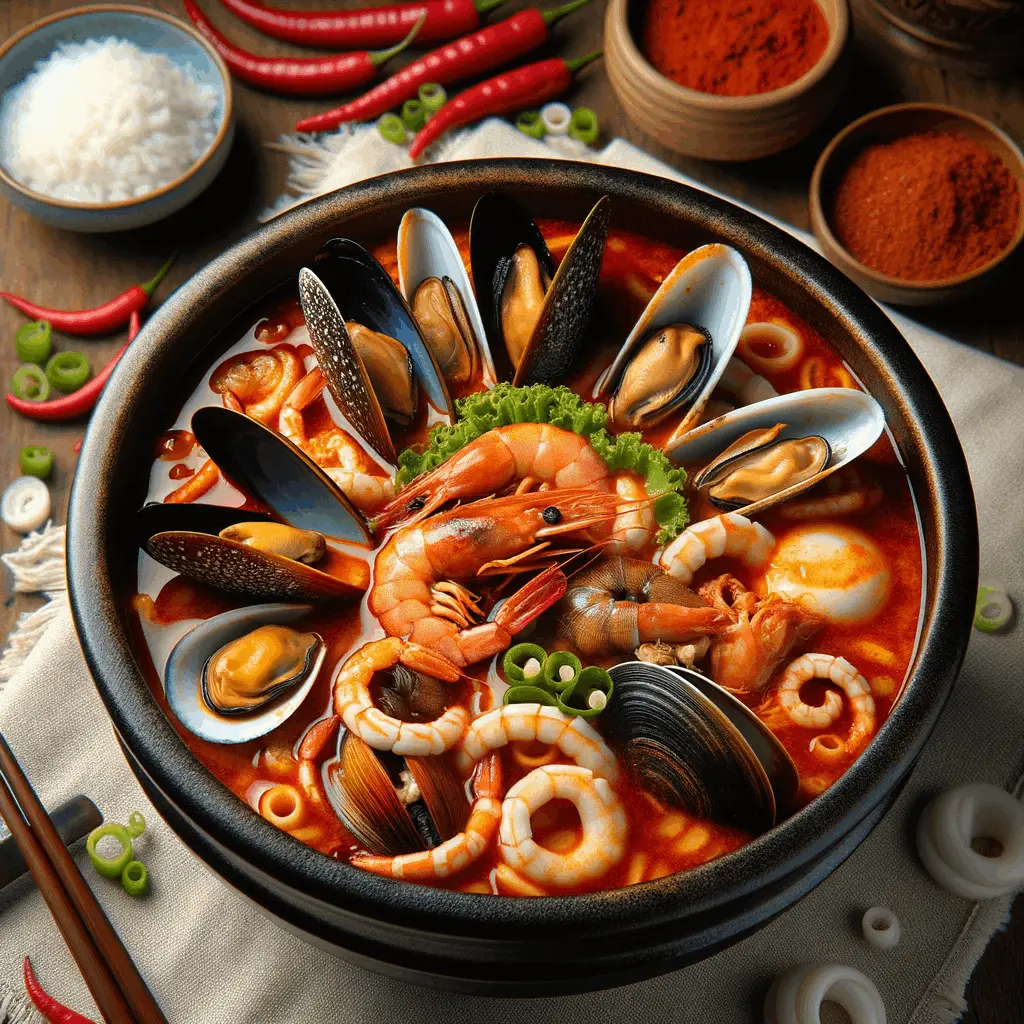Jjamppong, A Feast for Seafood Lovers

Article by Gil "hannaone"
© Copyright 2024. All rights reserved.
Image by hannaone
Introduction to Jjampong
Jjampong, also known as spicy seafood noodle soup, is a popular Korean dish cherished for its bold flavors and fiery kick. This hearty and aromatic soup is a favorite among seafood lovers and spice enthusiasts alike.
Loaded with a variety of fresh seafood, vegetables, and chewy noodles, Jjampong offers a delightful feast for the senses. Whether enjoyed as a comforting meal on a chilly evening or as a satisfying treat any time of the year, this dish never fails to captivate the taste buds.
History and Origin
Jjampong traces its roots to the Chinese-Korean culinary scene, combining influences from Korean cuisine with Chinese spice and noodle traditions. While the dish is derived from the Chinese Shandong-style chǎomǎmiàn (炒碼麵), it has been modified to Korean taste.
During the Japanese occupation of Korea (1910–1945), the Japanese saw chǎomǎmiàn in Chinese restaurants in Korea and named it chanpon, as the white soup seemed similar to the soup of chanpon to their eyes. The Japanese word was subsequently adapted phonetically into Korean as jjamppong.
Unlike the original chǎomǎmiàn, which traditionally used a white bone broth, jjamppong mainly features stir-fried seafood and vegetables with the addition of gochugaru.
This fusion dish has evolved over time to become a quintessential part of Korean culinary culture, adored for its vibrant flavors and satisfying ingredients. Originating from the port city of Incheon, Jjampong has gained popularity throughout Korea and beyond, earning its place as a beloved staple in Korean cuisine.
Ingredients in Jjampong
The rich and complex flavor profile of Jjampong is a result of its diverse range of ingredients. This delectable soup typically features an array of seafood such as mussels, shrimp, squid, and clams, creating a symphony of oceanic flavors.
Additionally, the broth is infused with spicy gochugaru (Korean chili flakes), aromatics like garlic and ginger, and an assortment of vegetables such as cabbage, onions, and scallions.
The inclusion of chewy, elastic noodles further enhances the dish, making it a hearty and complete meal. The harmonious blend of these components results in a soup that is robust, spicy, and deeply satisfying.
Benefits of Seafood in Jjampong
For those who cherish the bounties of the sea, jjampong, a Korean spicy seafood noodle soup, is a treasure trove of nutritious delights. The briny depth of the ocean's flavors is encapsulated in every spoonful, with an assortment of seafood that typically includes mussels, shrimp, squid, and clams.
Seafood, the star of jjampong, is rich in omega-3 fatty acids, known for promoting heart health and brain function. Each bowl offers a high protein content with lower calories compared to other protein sources.
The array of seafood in jjampong also provides essential vitamins and minerals, such as Vitamin B12 and selenium, contributing to a balanced diet.
Moreover, the spicy broth, often accentuated with gochugaru (Korean red pepper flakes), can help boost metabolism, resulting in a dish that is not only mouthwatering but also beneficial to your well-being.
How to Make Jjampong at Home
Creating a comforting bowl of jjampong in the familiar setting of your kitchen is a venture worth pursuing. Initiate the process by preparing a rich and fiery stock infused with kelp and anchovies—this forms the backbone of jjampong's unique taste.
Proceed by stir-frying your chosen seafood medley with garlic, onion, and ginger until just opaque, releasing their sea-kissed aromas. Elevate the heat with generous helpings of gochugaru, followed by a lush pour of the prepared stock.
Simmering is key, allowing the flavors to marry and intensify. For that signature chewy texture, cook the noodles separately until al dente, then combine them with the seafood broth, crowning your dish with julienned vegetables for crunch and color.
Keep in mind, the key to an authentic jjampong experience is the harmony of spicy, savory, and fresh maritime flavors, all converging in a single bowl.
Variations and Customizations
Jjampong lends itself to the creative whims of its maker, making it a versatile dish adaptable to diverse tastes and dietary needs. Seafood lovers can amplify their bowl with additional favorites like crab or lobster.
For those seeking a less spicy rendition, adjusting the amount of gochugaru paves the way for a milder soup, without compromising on depth.
Vegetarians can substitute seafood with kelp, types of seaweed, sea purslane, salicornia (sea bean), an abundance of mushrooms, and tofu, still keeping the essence of Jjamppong alive.
To cater to the carb-conscious, noodles can be replaced with spiralized vegetables, presenting a lighter yet equally satisfying experience. Whether you favor indulgence or health-conscious alterations, jjampong's versatility ensures it remains a beloved dish for everyone. Remember, personal flair and preference take precedence, crafting a jjampong that resonates with your palate.
Serving and Pairing Suggestions
Jjampong Cuisine Jjampong, a beloved Korean spicy seafood noodle soup, is a satisfying dish perfect for chilly days. Its depth of flavor and variety of seafood make it a seafood lover’s dream. When serving jjampong, consider pairing it with a side of steamed rice or Korean-style pickled vegetables like kimchi. The neutral flavor of rice complements the spiciness of the soup, while the tangy and crunchy kimchi provides a refreshing contrast to the heat. Beverage Pairings To balance the heat of jjampong, consider serving it with makgeolli a cold, crisp Korean beer, a local lager or pilsner. The carbonation and mild bitterness of these beers can help cool down the palate between spoonfuls of the savory and spicy broth.
Conclusion
Enjoy the Jjampong Experience Jjampong is a delightful dish that offers a tantalizing mix of seafood, noodles, and a spicy broth. It's a popular choice for those seeking a flavor-packed meal that satisfies the senses. Whether enjoyed on its own or paired with complementary sides and beverages, jjampong is a standout choice for any seafood enthusiast or home cook looking to broaden their culinary horizons with an authentic Korean delight.

AI rendition of Jjamppong
Image by AI


